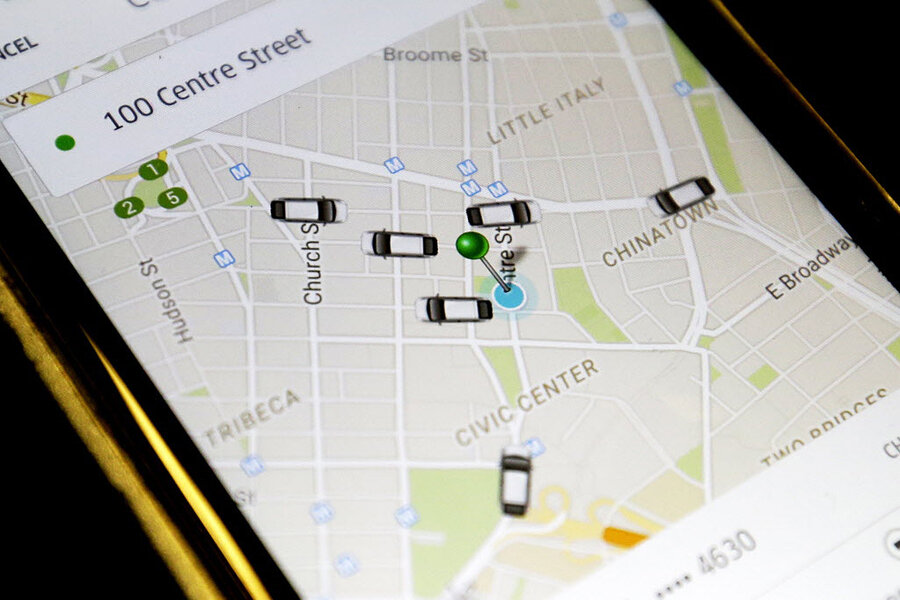Why Uber's surge pricing doesn't work quite as expected
Loading...
Like unpleasant weather in New England, the secret to avoiding Uber’s surge pricing – the company’s practice of upping the price for a ride at peak hours when the demand for cars outstrips the number of drivers – may be to simply wait five minutes.
That’s one conclusion from a study of the algorithm that powers the ridesharing company’s service by researchers at Northeastern University presented on Thursday at the Internet Measurement Conference in Tokyo.
Uber has long said that surge pricing is what makes its on-demand ride service work, encouraging drivers to go to more in-demand areas in order to pick up the higher price fares, which can help bring supply and demand for the rides closer together, aiding passengers.
But researchers Le Chen, Alan Mislove, and Christo Wilson found that while surge pricing – which updates prices every 5 minutes – is responding to supply and demand, it isn’t working exactly as Uber intended.
In some cases during a surge – which often lasts less than 10 minutes and in some cases less than 5 minutes – drivers can actually drive away from the in-demand areas.
“What we see is that demand drops precipitously, cars stop getting booked and drivers are just sitting there,” Professor Wilson, who teaches at Northeastern’s College of Computer and Information Science, told NPR. “If the incentive was working the way it should, you would expect there always to be an incentive for [drivers] to always move in. But in this case, the result is mixed."
The researchers tested Uber’s algorithm in Manhattan and San Francisco, creating 43 accounts that would virtually request rides from fixed points in each city, enabling them to record information about Uber drivers in the two cities. They then tested their methodology on a publicly-available database of New York taxicabs, eventually combining their own Uber data with the company’s studies and publicly available data.
Uber argued the researchers’ findings didn’t show the full picture. “Contrary to the findings in this report — which is based on extremely limited, public data — we’ve seen this work in practice day in day out, in cities all around the world,” Uber spokeswoman Molly Spaeth told ProPublica in an e-mail.
The company has previously said that surge pricing is in effect in a small number of trips, but the researchers found that surge pricing affects rides in Manhattan about 14 percent of the time and about 57 percent of the time in San Francisco, despite the fact that there are more Ubers in the West Coast city.
Part of the issue, the researchers say, is that Uber has manually divided many cities into distinct surge areas – Manhattan has 16, London has 19, Boston has 9 – where prices are set independently of each other. It’s still unclear how Uber has made these divisions.
As a result, waiting a few minutes or walking a few blocks out of the surge area can dramatically reduce prices, Wilson says.
Surge pricing has also faced some criticism from drivers, who Wilson says aren’t given enough time to respond to the surges and have to deal with demand that reflects the need for rides from five minutes earlier, NPR reports.
“Many drivers I know would rather rely on a steady rate where they can make a living instead of chasing the surge,” Suleman K., an Uber driver in New York City, who didn’t want his full name used because he has been driving for the company full-time for two years, told CNET.
Earlier this month, the company aimed to address some of these concerns, unveiling a redesigned app for its drivers that features a “heat map” showing drivers where their next ride is likely to come from – whether surge pricing is in effect or not.
But the study was particularly aimed at looking under the hood at what Wilson calls Uber’s “opaque” pricing model.
The researchers say it differs from other online marketplaces such as Craigslist, eBay, and Airbnb because both buyers and sellers have information about what products are available and how much they cost. With Uber, the researchers argue, making price comparisons is more difficult because the company’s algorithm does much of the work.
“Uber is different,” he told NPR. “They have this algorithm, and they say it changes prices based on supply and demand, but it's a black box. You have to trust that it's working correctly, because you can't verify. You don't know how many customers there are, you don't know how many other drivers there are.”







